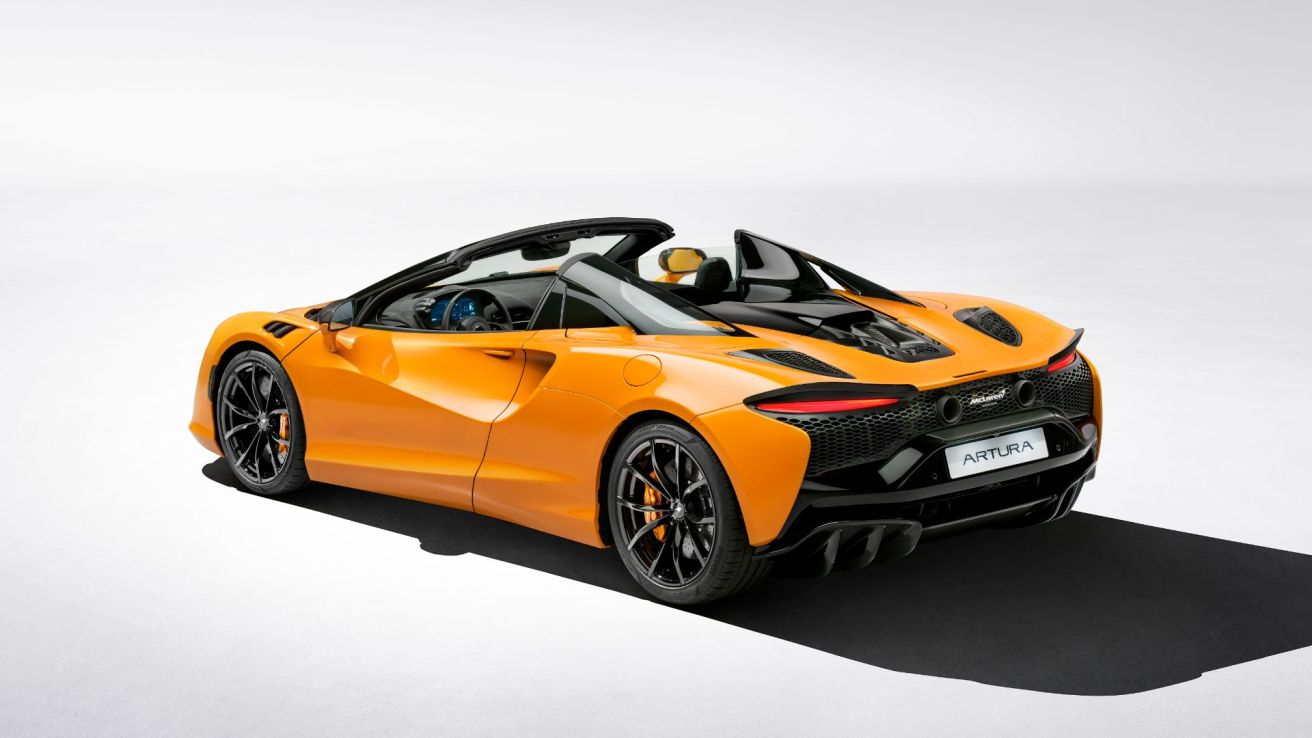New McLaren Artura Spider is a 700hp hybrid head-rush
Tim Pitt gets a first look at the McLaren Artura Spider. The open supercar promises more power and 'no compromise' dynamic performance.


McLaren has lifted the lid off its plug-in hybrid supercar. The new McLaren Artura Spider promises more power, ‘no compromise’ dynamic performance, a spicier soundtrack and option to go al fresco.
Priced from £221,500 – a premium of around £31,000 over the Artura coupe – the Spider is available to order now, with first deliveries expected this summer.
We visited McLaren’s futuristic factory in Woking for a secret preview of the Artura Spider, followed by a chat with the senior engineers who developed it. Read on for everything we know so far.
Open to the elements
There is more to the Artura Spider than just a new roof, but that’s the headline news here. Powered by eight electric motors, it disappears acrobatically and near-silently beneath the rear deck in 11 seconds – and at speeds up to 31mph.
The roof itself is made from unpainted carbon fibre composite, with an optional electrochromic glass panel that goes from opaque to transparent at the touch of a button.
Made in Sheffield, the Spider’s ultra-rigid ‘MCLA’ carbon fibre chassis requires no extra strengthening to compensate for its opening top. However, the roof motors and mechanism mean 62kg of added weight.
McLaren quotes a lightest dry figure of 1,457kg, plus a kerb weight of 1,560kg: measured with all fluids and the fuel tank 90 percent full. “Either way, we have the lightest convertible supercar in its class,” says chief engineer Andy Beale.
More power, more range
The Artura Spider also gains an extra 20hp, bringing total output to 700hp at 7,500rpm. Key performance stats are identical to its coupe sibling: 0-62mph in 3.0 seconds and a top speed of 205mph.
Achieved via a software tweak for the 3.0-litre twin-turbocharged V6, the extra power makes its presence felt between 4,000rpm and the 8,500rpm redline. Maximum torque is unchanged at 531lb ft, but the axial flux motor contributes an instant 166lb ft for electrified throttle response.
McLaren has also reworked the eight-speed dual-clutch gearbox, introducing a new ‘pre-fill’ function that pressurises the hydraulic fluid to reduce shift times by 25 percent. And proving that you can, occasionally, have your cake and drive it, the Artura offers a longer zero-emissions range: up from 19 miles to 21 miles with the powertrain in fully electric E-Mode.
Thank you for smoking
We’ll come to the cosmetic differences in a minute, but there are further changes beneath the Spider’s skin. New damper valving and improvements to its innovative ‘ethernet’ electronic architecture make the adaptive suspension up to 90 percent quicker to react. “We’ve increased the bandwidth of the car,” explains Andy Beale, a veteran of 21 years at McLaren. “It combines a more supple ride with better body control.”
Beale also highlights the new brake cooling ducts, which provide “greater stopping power and consistency at high speeds”, and the retuned exhaust system with its “cleaner tone” and greater crescendo as the revs rise.
Oh, and if all that sounds a bit serious, a new “spinning wheel pull-away” function complements the existing launch control, allowing you to blast off in clouds of dramatic tyre smoke – and probably vaporise a pair of Pirelli P Zeros in the process. Note: don’t try this at the drive-thru.
The future is orange
With the technical briefing complete, Artura programme manager Michael Norrington takes us for a walk around the first pre-production Spider. Resplendent in Papaya Spark – a pearlescent version of McLaren’s trademark bright orange, seen above – it outshines even the sparkling white tiles of the factory’s inner sanctum.
Unsurprisingly, most of the design changes are focused around the Spider’s rear end. The ‘hot vee chimney’, which vents heat from the hybrid powertrain, has moved backwards by around 200mm to avoid scorching the folded roof, and now has additional air intakes on either side.
Unique to the Spider are shapely rear buttresses made from motorsport-style clear polycarbonate. “They were a real engineering challenge,” admits Norrington, “but they have two functions: improving visibility and channeling cold air into the engine compartment.”
Look closely and you’ll also spot small gurneys on the windscreen header rail, designed to deflect air over the cabin, plus the new vertical rear window. The latter drops down electrically so your ears can enjoy unfettered access to the snarling 120-degree V6, even on a wet day in Woking.
Get yourself connected
McLaren CEO Michael Leiters says the Spider offers “even higher levels of connection, without any compromise in everyday driving.” We’ll test that claim at the launch in a few months’ time, but the regular Artura has already set a high bar. Our review described it as ‘a multi-faceted and very modern kind of supercar… efficient and unobtrusive when you’re not in the mood, then riotously fast and entertaining when conditions allow’.
In the meantime, the good news is that most of the improvements made to the Spider will be carried across to the coupe, as part of a 2025 model-year update.
Existing Artura owners can also visit their McLaren dealer to receive the 700hp power upgrade free of charge. The electric range extension won’t be offered, however, as doing so would contravene homologation rules and require the car to be re-registered.
Tim Pitt writes for Motoring Research


